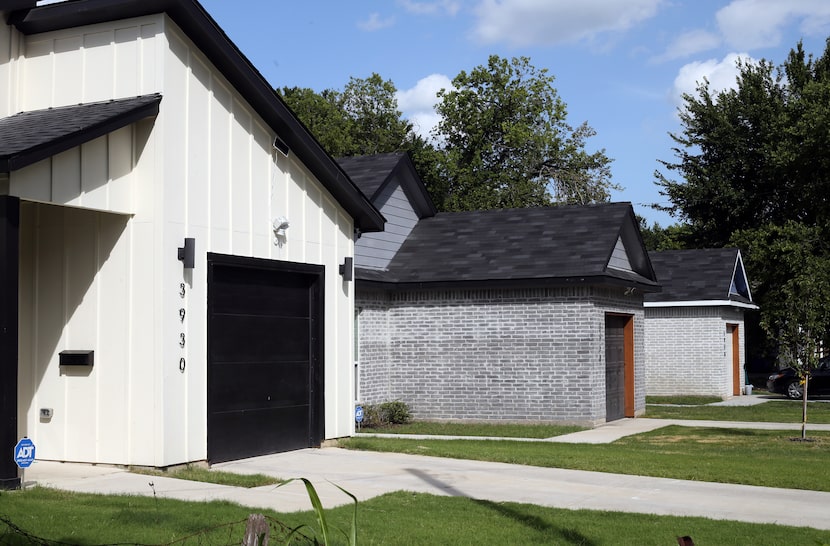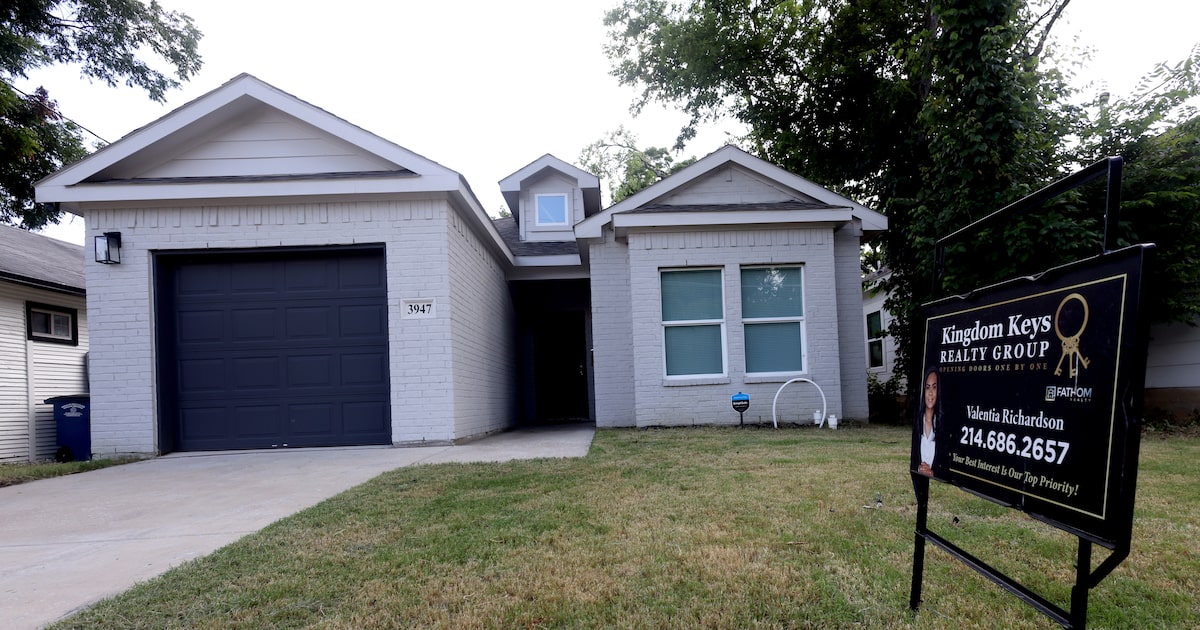The Dallas-Fort Worth home market is squeezing both buyers and sellers.
Median sales prices are falling, but more expensive homes aren’t selling as quickly. Homes sit on the market for roughly a week and a half longer than they did last year. Sales are down, and some would-be sellers have considered renting out their properties instead.
Economic uncertainty, stubbornly high prices and interest rates hovering around 7% are keeping some buyers out of the market.
“This is going to be a difficult year for the buyers,” said Sriram Villupuram, a real estate and finance professor at the University of Texas at Arlington. “Sellers have options. It could be a difficult year or they could rent (the home out) and punt the ball for now. … It’s going to be tough.”
D-FW Real Estate News
Related:‘Buyers aren’t biting.’ D-FW home prices flat year over year
Still, buyers could find a good deal if they look. Homebuilders have a larger supply of finished speculative homes sitting on the market, and they are offering generous incentives. Some homebuilding firms have begun to lay off employees as the market has turned.
Falling prices
Several key metrics help paint the picture of the Dallas-Fort Worth housing market.
Real estate website Redfin predicted that home prices would begin to fall by the end of 2025, and Dallas has seen median home prices fall at one of the fastest rates.
In 11 of the nation’s 50 largest metros, home prices have declined year over year. Prices in the Dallas area have fallen 4.6% over the last year as of May, behind only Oakland, Calif. (-6.7%) and Jacksonville, Fla (-5.2%).
Housing markets across Florida and Texas have cooled rapidly “amid a surge in homebuilding, rising insurance costs and extreme weather events,” Redfin reported.
 These three recently constructed houses are new additions to the 3900 block of Coolidge Street in Dallas. New homes are being constructed to help meet the growing demand throughout the D-FW housing market. Photos of new home construction in the 3900 block of Coolidge Street in Dallas were taken on June 30, 2025. (Steve Hamm / Special Contributor)
These three recently constructed houses are new additions to the 3900 block of Coolidge Street in Dallas. New homes are being constructed to help meet the growing demand throughout the D-FW housing market. Photos of new home construction in the 3900 block of Coolidge Street in Dallas were taken on June 30, 2025. (Steve Hamm / Special Contributor)
Other reports show similar price trends.
The Case-Shiller national home price index report shows home prices in Dallas are falling slightly. The year-over-year decline is less than 1%. Of the 20 major metros tracked in the report, only Tampa (-2.15%) reported a larger decline. The remaining metros saw slight price growth.
The Case-Shiller index is a three-month moving average that compares sales price changes of specific properties over time to provide a more accurate picture of market trends. It measures changes in the total value of all existing single-family housing stock.
Data from Texas A&M University’s Texas Real Estate Research Center, the MetroTex Association of Realtors and the North Texas Real Estate Information Systems shows the median price of a home sold on the MLS was $399,000 in May, down 2.2% from the prior year.
Sitting on the market
Median prices might be dropping. Other metrics show that homes are just sitting on the market.
Homes were on the market for an average of 86 days — 11 days longer than last May, according to data from the MetroTex Association of Realtors.
The stock of Dallas-Fort Worth housing inventory has increased to 4.7 months. That’s the highest since July 2012.
Months of housing inventory tracks roughly how long it would take all the homes on the market to sell at the current pace.
Experts generally consider an inventory of five or six months as balanced between buyers and sellers.
There were 35,555 active listings in the region, up 37.2% from last May.
There were 9,195 closed transactions in May, down 2.5% from last year.
The data seems to suggest that buyers are going after lower-priced homes, Villupuram said.
“People are resigning to the fact that interest rates are not going down as many had predicted because of new uncertainties,” he said. “(They) are going to settle for something smaller and lower priced given the high interest rate. … It’s still not yet a correction on the market.”
Buyers, sellers and renters
Real estate agents and the head of a market research firm that tracks Texas’ new home industry have all noticed some changes in recent months.
For Todd Luong, a RE/MAX agent in Frisco, he’s noticed that more would-be buyers and sellers are more comfortable entering the rental market.
Many would-be sellers have seen the equity in their homes increase over the past few years. Their mortgage rates are also low, so they aren’t in a rush to sell. Would-be sellers don’t want to come down on the price too much, so they’d rather rent out the property.
More sellers are double-listing their properties, offering the home for sale or rent.
“Two, three or four years ago, you’d never hear of anything like this,” he said. “A seller wouldn’t ever think about keeping the property as a rental. It never even crossed our mind, because we just knew it was going to sell.”
Jim Fite, president and CEO of Century 21 Judge Fite Co., said he’s noticed homes at the higher end of the market are sitting longer than usual.
“The upper price range, from what I’m seeing, takes a little longer to sell than it did in previous months. When you get under $700,000 they’re moving very well in comparison,” he said.
His firm is also seeing more would-be sellers listing their properties for rent. The company manages 1,800 rental properties.
“(Their) equity is not such that (they are) going to lower the price to make it more competitive so it’ll move quicker,” Fite said.
Renting has become more popular in North Texas in recent years.
D-FW claimed four of the five fastest-growing suburban rental markets in the country between 2018 and 2023, according to an analysis by Point2Homes, a rental market research firm.
Rents for single-family homes are falling in the region. Dallas single-family rents fell year over year for the second consecutive month in April. The 0.4% drop was the lowest rent price growth in the nation, according to the Cotality Single-Family Rent Index.
Cotality points to the region’s apartment supply boom as a driver behind the rent drops.
“Dallas has seen large numbers of new multifamily rental units coming online. These new units give renters some bargaining power, which can cause a softness in all rental prices,” said Molly Boesel, Cotality’s principal economist. “As these new units are rented out, rents may begin to firm up again. Also, as potential home buyers continue to search for homes they can afford, you may see this population remain in the rental market, and potentially move to single-family rentals, which are often considered a ‘move-up’ from apartments.”
Still, Fite says, would-be buyers aren’t flocking to the rental market in droves.
“Depending on the submarket. … I’ve actually lowered the rent in some cases,” he said. “Very few, but a few. … It’s definitely a softer market than it was a few years ago.”
A few of Luong’s would-be buyers stopped their home search in April, but others are deal-hunting. One of his clients recently got lucky — an accepted offer $30,000 under the asking price.
“A lot of buyers are making these lowball offers sometimes, because they do think that there’s this possibility of market uncertainty,” he said.
Builder woes
Builders are dealing with their own issues, said Ted Wilson, who leads Dallas-based market research firm Residential Strategies.
At the end of March, there were 11,574 finished vacant homes, up 4.3% from year’s end. The rise in unfinished inventory has triggered price discounts and further buyer incentives, cutting builders’ profits.
Builders have remained aggressive, continuing to build speculative homes — homes built without a particular buyer in mind.
Firms are doing this for a variety of reasons. Builders need to keep their teams busy, and they need to “chew through” a larger number of lots that are now ready. More are in the pipeline, Wilson said.
The market is more challenging than it was at the start of the year for builders.
“There have been some layoffs around town, but people have been trying not to do that if they can help it,” he said. “The rate buydowns are out there, and they certainly work better with speculative homes.”
It’s not all gloom and doom for builders. While profit margins are compressed, homes are still selling, Wilson said.
“The big difference from 2008 is that if you’re willing to discount, you can usually find a clearing price for houses in every neighborhood,” Wilson said. “I think there are some builders that are saying ‘Okay, we’re gonna have certain neighborhoods where we don’t make any money, but we have others where we are making money. We’ll just lump it all together, and that’s our return.’”
Residential Strategies estimates roughly 46,500 homes will be started by builders in 2025 — the fewest since 2019.
Despite the slowdown, 2025 is expected to rank in the top 10 for homes started in a year since 1990.
What’s next?
Villupuram, Fite and Luong agreed that little would shift through the summer and the remaining year without a change in interest rates.
The average 30-year mortgage rate is 6.77% as of June 26, according to FreddieMac. Mortgage rates have been stable, fluctuating within a 15-basis-point range since mid-April.
“We are where we are unless we have an interest rate change that makes a difference,” Fite said.
Villupuram said sellers and buyers will struggle unless interest rates go down.
“It’s going to be rough,” he said.
